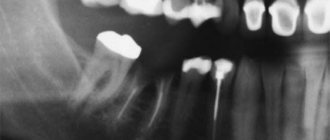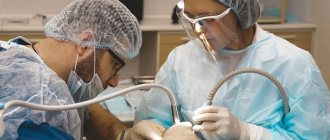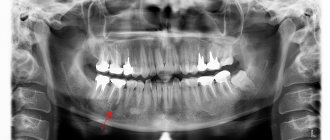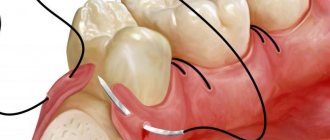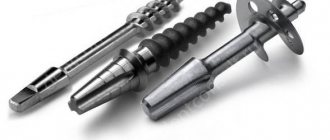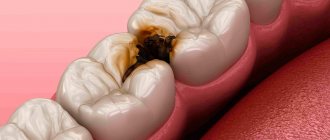Tooth root removal is one of the most labor-intensive and complex procedures in modern dental practice. The indication for its implementation is the preservation of the root part of the tooth in the gum, subject to complete destruction of the crown (for example, in severe forms of caries, as a result of injury or illiterate dental treatment). Untimely operations to extract such units is a factor contributing to the development of a whole range of diseases (periodontitis, periostitis, etc.). That is why “problem” roots must be removed as soon as possible.
In what cases is tooth root removal required?
The key goal of modern dentistry is tooth preservation. However, in some situations, extraction is considered the only way to solve the problem. Teeth may also fall out or become fractured. In this case, the main indication for surgical intervention is the remainder of one or more tooth roots after a fracture, tooth loss or extraction. It is not recommended to ignore its presence, as in the future it can provoke the appearance of a focus of inflammation or the development of a purulent disease.
So, tooth root removal is carried out in the following situations:
- Pain syndrome appeared in the area of gingival tissue. The patient periodically experiences a sensation of “twitching” in the gum area;
- There is swelling in the soft tissue area;
- Acute pain occurs when pressure is applied;
- There is an inflammatory process, bleeding and redness;
- Body temperature rises.
If you encounter at least one sign indicated in this list, you must immediately begin treatment procedures. If the patient refuses treatment, serious complications can occur, including sepsis.
Preparing for extraction - what awaits you in the dentist's office
Before removing the destroyed root, the doctor first examines the patient, selects a method of pain relief, instruments and treatment methods. The preparation process takes into account the individual characteristics of the patient, his age, tendency to allergies and the nature of the problem with which he applied.
Then the oral cavity is sanitized. If necessary, plaque located in close proximity to the treated area is removed. The doctor puts a sterile cape on the patient and gives an anesthetic injection. For this, the thinnest possible needle is used, which makes the procedure almost painless. When the root lies deeper and is not visible during visual inspection, gum exfoliation is performed.
Tools used during extraction:
• drills;
• elevators;
• tongs;
• syringes.
The choice and use of tools depends on the removal technique.
Once everything is ready, the doctor performs a syndesmotomy and then removes the roots with forceps, uses a rotation technique, or uses an elevator. Straight-grip forceps or a bayonet-shaped instrument are used to extract the roots of the upper jaw. To manipulate the lower jaw, beak-shaped forceps are used.
How is the root removal process performed?
The extraction procedure is usually divided into complex and simple.
Typically, removal is carried out with special forceps, eliminating the risk of the unit loosening in the gum tissue.
During complex extractions, the tissue is initially dissected. The suturing process is carried out after completion of the procedure.
Examination and preparation
The preparation period is accompanied by an examination of the entire oral cavity and directly the area that requires surgical intervention. An important point at this stage is the choice of an appropriate method of anesthesia. The following factors must be taken into account:
- The age group the patient belongs to;
- The presence of chronic pathologies;
- The likelihood of allergization of the body when using certain medications.
A special individual approach is required in situations where surgical tooth root removal is planned in young children. If a child has elevated blood sugar levels or is prone to spontaneous seizures, special treatment regimens are selected for him.
In addition, before performing the manipulation, the gums are examined. This makes it possible to detect inflammatory processes and purulent foci, as well as develop the correct treatment plan.
Anesthesia
The vast majority of surgical interventions are performed using local anesthetics. In this case, the surgeon must clarify whether the patient has restrictions on certain anesthetics. During complex surgical interventions, the doctor may put the patient into medicated sleep to prevent the occurrence of severe pain.
Simple tooth root removal using an elevator
We are talking about a simple removal of the tooth root. This technique has been well tested and does not pose any difficulties for specialists. Its duration, as a rule, does not exceed several minutes. In this case, the possibility of using special equipment is not provided. The dentist only needs to use elevators and forceps. Next, we describe the algorithm for performing this procedure:
- Initially, the gum is peeled off from the neck of the tooth.
- Then this part of the tooth is grabbed with forceps.
- Next, the unit is loosened. If there is a tooth with a multi-root system, it is rocked in different directions. If we are talking about a single-rooted tooth, rotate it 360 degrees;
- Removal is carried out;
- The alveoli are treated with an antiseptic composition and covered with a cotton swab.
If tooth root removal is performed on the upper jaw, forceps are used. They allow you to fix the unit well and then remove it from the hole. If we are talking about removing the roots of teeth in the lower jaw, it is advisable to use another tool - elevators. With their help, it is possible to grab the tooth in the lower part and weaken it in the alveolus.
What affects the complexity of the operation
The difficulty of removing the root elements of the dental system is influenced by a number of key factors:
• size and degree of development of tooth decay;
• presence of gum defects;
• fragility;
• condition of the oral cavity and mucosal tissues;
• internal location of the dental unit.
The dentist’s work becomes more complicated in the case of such defects as a broken crown, incorrect or excessively deep location of the roots, or their curvature.
Attending doctors at the Elident clinic
Mlodik Boris Naumovich
Dental surgeon, implantologist, orthopedist
Clinical experience : 26 years
Vakhrushev Alexander Viktorovich
Dental surgeon, implantologist, orthopedist
Clinical experience : 25 years
Difficult tooth root removal
Such surgical intervention is practiced if it is blocked by bone tissue, has an abnormal location, does not erupt for a long time, or has a complex root system. Most often, this surgical procedure is performed when the root of a wisdom tooth needs to be removed. This method is often used when it is planned to remove rotten tooth roots. To carry out the procedure, as a rule, a more extensive arsenal of tools is used: forceps, several drills, a scalpel, scissors, material for making sutures.
In addition, the fragmentation method is used when it is necessary to remove the remainder of the tooth root. In this case, the crown is cut into pieces, after which they are removed from the hole. After completion of the procedure, the alveoli are washed and the gum tissue is sutured.
Wisdom tooth root removal
Difficulties that arise when removing the eighth tooth are usually associated with the inclined position of its crown and the abnormal development of the root system in relation to the roots of neighboring units. This indicates the need for radiography, in particular if the crown is severely damaged. A specialist with sufficient experience must participate in the procedure. This will eliminate problems associated with the fact that the root was left behind during tooth extraction.
Application of elevators
In order to reach the root of a tooth with an elevator, the instrument is placed between the root and the alveoli. If necessary, a slight dislocation is performed. The root is then fixed and separated from the gum.
How is anesthesia performed?
The drug for anesthesia is selected taking into account the age and individual characteristics of the patient. The injection is done using the conduction method. The specialist places the medicine along the nerve endings. The drug blocks nerve impulses, the patient has a feeling of freezing, and he stops experiencing pain.
Root removal under general anesthesia
Modern dentistry allows you to carry out any manipulations with teeth, putting the patient to sleep using general anesthesia. This method is used if the patient, for some reason, cannot undergo conventional anesthesia or it does not have the desired effect on him. Often, general anesthesia is also used in cases of pathological fear of dental treatment, in childhood and in the presence of phobias.
Indications for dental treatment under general anesthesia:
• very large volume and particularly traumatic nature of the upcoming manipulations;
• pronounced gag reflex when touching the oral mucosa;
• the patient has mental disorders;
• allergies to anesthetic drugs;
• phobias and panic fear of the dentist;
Before general anesthesia, the patient must undergo all tests and undergo a consultation with an anesthesiologist. Only after the examination results the doctor decides on the possibility of using this method instead of traditional anesthesia.
Tooth root removal without tooth extraction
In some situations, root extraction is replaced by amputation. This is a manipulation that allows you to preserve the healthy part of the tooth by removing only a fragment of its root system. As part of the operation, the affected area is cut off, after which the resulting space is filled with osteoplastic material.
Dental preservation procedures also include hemisection, which involves the extraction of both a root fragment and a part of the crown located above it.
Thanks to these two methods, it is possible to preserve the functionality of the tooth and use it to fix the bridge structure. It should be remembered that, having lost part of the root, the tooth can quickly lose its stability.
That is, if you find that the tooth hurts for a long time after root removal, you need to visit an experienced specialist as soon as possible.
Is it possible to remove a molar tooth yourself?
Trying to remove a molar tooth yourself is extremely dangerous. The only exception is very severe tooth looseness. It should be borne in mind that complete removal even in this situation will not work. You will simply break off the body of the tooth from the root, and nothing more. In any case, after such an independent removal, you need to visit a dentist, who will determine what should be done next. Sometimes an artificial tooth is installed at the root, and it can last for more than one year. If the root has defects, then it has to be removed.
There are situations when you have to remove a child’s very loose baby tooth at home. In this case, you should thoroughly brush the baby’s teeth and disinfect the oral cavity. Then you should wrap your fingers in sterile gauze, loosen the tooth thoroughly, and only then try to pull it out. If this was not possible on the second attempt, then the child must be taken to the dental clinic in any case.
If you have successfully removed the tooth from the socket, then you must firmly place a gauze swab in the socket and leave it there for 30 - 40 minutes. In the next two hours, the child should not be allowed to eat or drink.
Even if the removal was successful, the baby still needs to be shown to the dentist. This is the only way to protect your child from possible complications.
Rehabilitation after tooth root removal
During this period, wounds heal, pain disappears and, within 4-5 days, swelling goes away.
At this stage, you should adhere to the following recommendations:
- Avoid eating after surgery;
- Use recommended medications;
- Stop drinking alcoholic beverages and tobacco products;
- Avoid using rinse solutions;
- Refuse to visit the sauna and steam bath, as well as take a hot bath;
- Minimize physical activity.
Preparation
Before the procedure, the doctor conducts a consultation, a detailed examination and an x-ray of the tooth to be extracted: the degree of damage to the dental crown and the presence of anomalies are revealed. Based on the diagnostic results and radiographs, a clinical picture is formed, the number, size, shape of the roots, their relationship with the mandibular canal and maxillary sinus, and the size of bone resorption are established.
When removing 8 units, be sure to take into account its position, the width of the retromolar space, and the depth of immersion. Based on these data, the doctor draws up a surgical procedure and selects surgical instruments.
If the patient has an inflammatory focus in the periodontium, antibiotics are prescribed 24 hours before the planned surgery. Patients who are terrified of the dental chair are given sedative preparation.
Our clinics
Clinic "Elident" on Varshavskaya
Varshavskoe highway, 75, bldg. 1, Moscow 117556
- Varshavskaya (500 m, closed until 2021)
- Nakhimovsky Prospekt (1,300 m)
Mon-Sat : 09:00-21:00; Sun : 09:00-19:00.
Online registration
+7 (495) 649-41-19
Elident Clinic in Annino
Varshavskoe highway, 154, building 1, Moscow 117405
- Annino (500 m)
- Academician Yangelya (700 m)
Mon-Sat : 09:00-21:00; Sun : 09:00-19:00.
Online registration
+7 (495) 649-41-19
Operation stages
- Pain relief
. General or local anesthesia is used, the anesthetic is selected depending on the health status, age, individual characteristics, and allergic status of the patient. - Impacted tooth
. Removing an impacted tooth is made difficult by limited access to the problem tooth - the crown part closed by mucous/bone tissue. After anesthesia, an incision is made into the mucous membrane, the unit is divided with a bur, and it is removed in fragments. - "Eight"
. The eruption of a wisdom tooth in 75-80% of cases occurs against the background of complications and pain, so it is better to remove it in order to avoid problems with the gums and healthy neighboring units in the future. The operation is performed under anesthesia: the doctor dissects the gum and extracts the tooth. The edges of the wound are connected and sutures are applied. - Root
. The complexity of the manipulation depends on the presence/absence of inflammation, the degree of neglect of the diseased tooth, the depth of the branches: the root is cut, the crown is destroyed into individual elements, and all tooth fragments are removed.
Complications after tooth root removal
In some situations, after extraction, an infection gets into the hole. This is fraught with serious complications. That is, if your temperature has risen, the pain does not go away, or swelling occurs, you should immediately contact the dentist. If inflammation of the socket occurs after tooth root removal, this pathology can be easily treated if measures are taken in a timely manner.
If the patient claims that he has a root left after tooth extraction, this may be accompanied by severe inflammatory processes in the area of nearby tissues and acute pain. In this case, experienced specialists recommend performing repeated surgery, which will eliminate the possibility of severe pathologies in the gum area and the development of sepsis.
Our dentistry is staffed by experienced surgeons who carefully study the results of X-rays and CT scans and draw up a competent treatment plan. This eliminates the possibility of any medical errors and complications in the future.
Indications
If the condition of the tissues around the root is good and there are no inflammatory processes, then it can be preserved. Indications for extraction are usually:
- root fracture, cracks and other mechanical damage;
- inflammation of surrounding tissues;
- complete destruction of the upper part without the possibility of installing a pin or tab to fix the prosthesis;
- preparation for subsequent implantation.
How to restore dentition after tooth extraction?
One of the most popular questions among patients is: “What treatment is best to choose after tooth root removal?”
Most often, the doctor fixes a bridge-type prosthetic structure. However, this involves the need to remove the pulp and grind down adjacent units, and related problems.
According to most experts, the optimal choice is dental implantation. Using this design, you can reproduce several missing teeth at once. The final stage of implantation is the fixation of the crowns to the implant. But the key advantage is the ability to install a dental implant immediately after removing the root of a broken or abnormally located tooth.
Our specialists have impressive experience in the field of surgery and implantology, which allows them to perform the most complex dental procedures with minimal tissue trauma, based on modern protocols and with a guarantee of prolonged results. At the same time, we focus on the use of innovative technology and premium materials.
How long does it take for a wound to heal?
Normally, the wound surface heals in 4-5 weeks. In older patients, healing is delayed due to decreased tissue repair and reduced blood circulation.
The rate of healing depends on the extent of the procedure and the roots. In the case of complex removal of a molar with 3-4 roots, the process of tissue regeneration is delayed up to 20-25 days.
Restoration of gum tissue goes through the following stages:
- in the first days, the wound is closed by a blood clot (thrombus), formed as a result of stopping the bleeding;
- 3-4 days after removal, the thrombus resolves, and new tissue appears on the surface of the wound in the form of a thin film;
- bone tissue forms on the sides of the socket already at 3 weeks;
- after 3-6 months, the hole heals and has no differences with the jaw bone.
The speed of wound healing after removal depends on the characteristics of the body and the age of the patient. If necessary, the doctor corrects the tissue regeneration process with medications and physiotherapeutic methods.
Prices for tooth root removal in Elident
| Service | Price, ₽. |
| Tooth root removal | from 1 500 |
| Root resection | 4 000 |
It is not possible to calculate the exact cost of the extraction procedure without taking into account individual parameters. However, if you are planning to apply for tooth root removal, the price for this manipulation in Moscow can be determined based on the following factors:
- Complexity of the case. The cost of a simple extraction is much lower than the procedure associated with removing a complex tooth.
- Oral cavity condition. Before removing a tooth, you should make sure that there are no inflammatory foci in the area of the gum tissue. If the problem does occur, it is necessary to undergo appropriate treatment.
- Root system parameters . A small single root is much easier to extract than a massive root system in a complex tooth.
- Abnormal location . If for any reason the tooth has not erupted or has abnormal development within the gum tissue, the extraction procedure should only be performed by an experienced specialist. This will eliminate any complications in the future. All procedures related to treatment, extraction and reconstruction of missing teeth can be completed with the latest equipment, under the guidance of specialists with extensive experience, in comfortable conditions and at an affordable cost.
Article expert (author):
Complications
Deterioration during removal rarely develops. But such a situation is still possible; in some cases, the Patient’s condition seriously worsens, especially if the doctor violates the removal technology. In practice, the following complications are noted:
- damage to blood vessels, which causes severe bleeding;
- removal, serious damage to the primordia of permanent units when removing milk;
- puncture wounds of tissue due to puncture of instruments, in this situation there is a high risk of damage to the carotid artery and other large vessels;
- development of an infectious lesion, alveolitis (if the instrument is not properly sterilized);
- ruptures, dislocations of ligaments;
- breakage, part of the elevator getting stuck in the wound;
- fractures of hard tissues when the load is exceeded towards the tips of the root part.
Rare cases include the formation of a granuloma in the area where the unit was removed. After eliminating the cyst, part of the nail of the doctor who performed the extraction was found in the tissue. Apparently it was cut off with an instrument during surgery.
Elevators are indicated for use if the coronal part is destroyed or for other reasons it is not possible to use forceps. For the operation, local anesthesia is used, which allows the Patient not to feel pain or discomfort.
The most frequently asked questions from our patients
What happens if the tooth root is left in the gum?
If the root of the tooth is left as is, it becomes a source of infection, and after some time serious complications may develop, for example:
- inflammation of the tissues surrounding the tooth, including bone;
- penetration of infection into the wound surface;
- periodontal disease.
What is a root canal and can it be treated rather than removed?
The root (or dental) canal is an anatomical space inside the root of a tooth filled with pulp. Cleaning and treatment of dental canals is a mandatory stage of dental fillings and prosthetics. In our clinic, for this purpose, we use self-adapting files of the SAF system, which carefully clean the canals from dead and diseased tissue, pus, and accumulations of bacteria, without injuring healthy areas of the tooth. Thanks to their hollow structure, the doctor can simultaneously treat the root canal with disinfectants and anti-inflammatory drugs. Root canals are preserved only if the tissues surrounding the tooth are not affected by pathological processes, and in the future the root can be used for prosthetics.
If the tooth can still be restored, root canal treatment (roots) of the tooth is performed. It can be successfully completed in our Moscow clinic.

